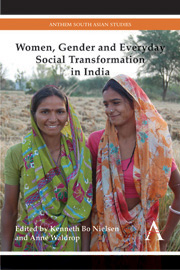Book contents
- Frontmatter
- Contents
- Acknowledgments
- Women and Gender in a Changing India
- PART I WORK, TECHNOLOGY, ASPIRATIONS
- Chapter One Today's ‘Good Girl’: the Women Behind India's BPO Industry
- Chapter Two Gender, Intersectionality and Smartphones in Rural West Bengal
- Chapter Three The Introduction of Electricity in the Sundarban Islands: Conserving or Transforming Gender Relations?
- Chapter Four Changing Consumption and the Negotiation of Gender Roles in Kerala
- Chapter Five Gender, Work and Social Change: Return Migration to Kerala
- Chapter Six Showtime and Exposures in New India: the Revelations of Lucky Farmhouse
- PART II DEMOCRACY AND THE DEVELOPMENTAL STATE
- PART III ASSERTIONS AND ACTIVISM
- About the Editors and Contributors
Chapter Six - Showtime and Exposures in New India: the Revelations of Lucky Farmhouse
from PART I - WORK, TECHNOLOGY, ASPIRATIONS
Published online by Cambridge University Press: 05 October 2014
- Frontmatter
- Contents
- Acknowledgments
- Women and Gender in a Changing India
- PART I WORK, TECHNOLOGY, ASPIRATIONS
- Chapter One Today's ‘Good Girl’: the Women Behind India's BPO Industry
- Chapter Two Gender, Intersectionality and Smartphones in Rural West Bengal
- Chapter Three The Introduction of Electricity in the Sundarban Islands: Conserving or Transforming Gender Relations?
- Chapter Four Changing Consumption and the Negotiation of Gender Roles in Kerala
- Chapter Five Gender, Work and Social Change: Return Migration to Kerala
- Chapter Six Showtime and Exposures in New India: the Revelations of Lucky Farmhouse
- PART II DEMOCRACY AND THE DEVELOPMENTAL STATE
- PART III ASSERTIONS AND ACTIVISM
- About the Editors and Contributors
Summary
The lucky among us now live in a world of allure and illusion – the world of maya – where all rice is basmati, all tea is Darjeeling, and where Bollywood is the last stop before heaven. With its stock of hard and soft power augmented by the blessings of deregulation, foreign direct and indirect investments, and the largest flow of official remissions anywhere in the world, India has acquired an attractive veneer. This rejuvenated India exerts its lure not only on resident Indians: New India is increasingly drawing into its net seekers from abroad. Two potentially competing flows of incoming people may be distinguished. First, an increasing number of nonresident Indians return from their overseas ‘bases’. These include the 30,000 Indians who left the UK in 2010 alone (BBC 2012). Though this flow does not match the larger stream of Indian immigrants into the UK, these 30,000 footloose Indians constitute a significant counterflow (Doughty 2012). Secondly, an increasing number of non-Indians, including white Westerners, now seek to include India in their careers or in their personal life projects. Age-wise, both flows include older people who want to enjoy retired life in the slow India of their memories or imaginations, as well as midcareer professionals who seek jobs similar to the ones they have had in the West. Both ethnoscapes also include young people who want to carve out a place for themselves among the creative or leisurely classes in New India. Our chapter is concerned with a segment of such spiralling and circulating transnational youth, specifically women of Western origin. As a case study of the increasingly common gendered West–East transnationalism and labour migration into formal and informal economic sectors, we look at the life trajectory of Lucky Farmhouse, a young Swedish model and sojourner to India. We will argue that Lucky Farmhouse’s sojourn is based on her erotic capital and that she has tried to reinforce her looks and talents by two seemingly contradictory strategies. One strategy casts her as a whistle-blower fighting Indian corruption. The other reveals her as an accomplice.
- Type
- Chapter
- Information
- Women, Gender and Everyday Social Transformation in IndiaA Revisionary History, pp. 89 - 102Publisher: Anthem PressPrint publication year: 2014



